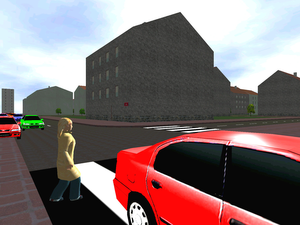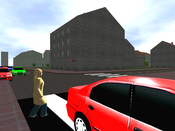Information
- Publication Type: Journal Paper (without talk)
- Workgroup(s)/Project(s):
- Date: November 2011
- ISSN: 1544-3558
- Journal: ACM Transactions on Applied Perception
- Note: Article No. 24
- Number: 4
- Volume: 8
- Pages: 1 – 22
- Keywords: bimodal task faciliation, pedestrian safety, virtual environments, audio-visual perception, head related transfer functions
Abstract
Audio rendering is generally used to increase the realism of Virtual Environments (VE). In addition, audio rendering may also improve the performance in specific tasks carried out in interactive applications such as games or simulators.In this paper we investigate the effect of the quality of sound rendering on task performance in a task which is inherently vision dominated. The task is a virtual traffic gap crossing scenario with two elements: first, to discriminate crossable and uncrossable gaps in oncoming traffic, and second, to find the right timing to start crossing the street without an accident.
A study was carried out with 48 participants in an immersive Virtual Environment setup with a large screen and headphones. Participants were grouped into three different conditions. In the first condition, spatialized audio rendering with head-related transfer function (HRTF) filtering was used. The second group was tested with conventional stereo rendering, and the remaining group ran the experiment in a mute condition.
Our results give a clear evidence that spatialized audio improves task performance compared to the unimodal mute condition. Since all task-relevant information was in the participants' field-of-view, we conclude that an enhancement of task performance results from a bimodal advantage due to the integration of visual and auditory spatial cues.
Additional Files and Images
Weblinks
BibTeX
@article{bernhard-2011-bmtf,
title = "Bi-modal Task Faciliation in a Virtual Traffic Scenario
through Spatialized Sound Rendering ",
author = "Matthias Bernhard and Karl Grosse and Michael Wimmer",
year = "2011",
abstract = "Audio rendering is generally used to increase the realism of
Virtual Environments (VE). In addition, audio rendering may
also improve the performance in specific tasks carried out
in interactive applications such as games or simulators. In
this paper we investigate the effect of the quality of sound
rendering on task performance in a task which is inherently
vision dominated. The task is a virtual traffic gap crossing
scenario with two elements: first, to discriminate crossable
and uncrossable gaps in oncoming traffic, and second, to
find the right timing to start crossing the street without
an accident. A study was carried out with 48 participants
in an immersive Virtual Environment setup with a large
screen and headphones. Participants were grouped into three
different conditions. In the first condition, spatialized
audio rendering with head-related transfer function (HRTF)
filtering was used. The second group was tested with
conventional stereo rendering, and the remaining group ran
the experiment in a mute condition. Our results give a
clear evidence that spatialized audio improves task
performance compared to the unimodal mute condition. Since
all task-relevant information was in the participants'
field-of-view, we conclude that an enhancement of task
performance results from a bimodal advantage due to the
integration of visual and auditory spatial cues.",
month = nov,
issn = "1544-3558",
journal = "ACM Transactions on Applied Perception",
note = "Article No. 24",
number = "4",
volume = "8",
pages = "1--22",
keywords = "bimodal task faciliation, pedestrian safety, virtual
environments, audio-visual perception, head related transfer
functions",
URL = "https://www.cg.tuwien.ac.at/research/publications/2011/bernhard-2011-bmtf/",
}



